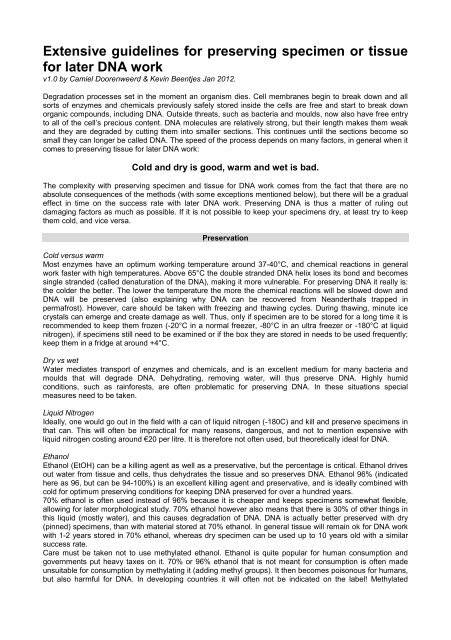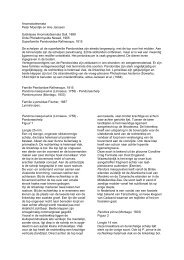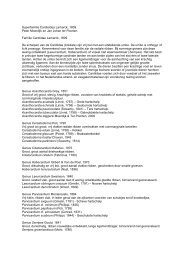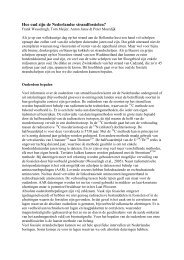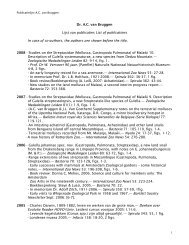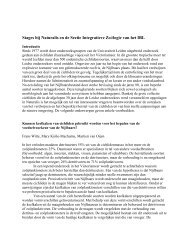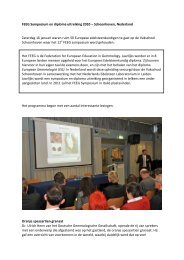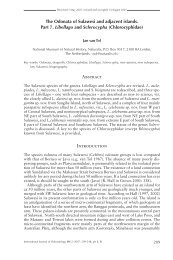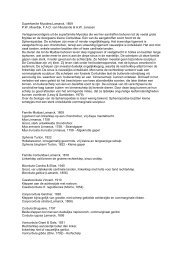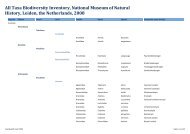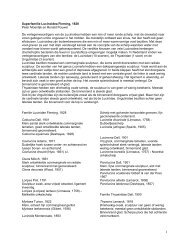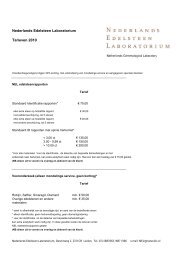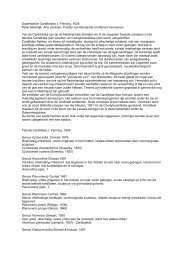Extensive guidelines for preserving specimen or tissue for later DNA ...
Extensive guidelines for preserving specimen or tissue for later DNA ...
Extensive guidelines for preserving specimen or tissue for later DNA ...
You also want an ePaper? Increase the reach of your titles
YUMPU automatically turns print PDFs into web optimized ePapers that Google loves.
<strong>Extensive</strong> <strong>guidelines</strong> <strong>f<strong>or</strong></strong> <strong>preserving</strong> <strong>specimen</strong> <strong>or</strong> <strong>tissue</strong><strong>f<strong>or</strong></strong> <strong>later</strong> <strong>DNA</strong> w<strong>or</strong>kv1.0 by Camiel Do<strong>or</strong>enweerd & Kevin Beentjes Jan 2012.Degradation processes set in the moment an <strong>or</strong>ganism dies. Cell membranes begin to break down and alls<strong>or</strong>ts of enzymes and chemicals previously safely st<strong>or</strong>ed inside the cells are free and start to break down<strong>or</strong>ganic compounds, including <strong>DNA</strong>. Outside threats, such as bacteria and moulds, now also have free entryto all of the cell’s precious content. <strong>DNA</strong> molecules are relatively strong, but their length makes them weakand they are degraded by cutting them into smaller sections. This continues until the sections become sosmall they can longer be called <strong>DNA</strong>. The speed of the process depends on many fact<strong>or</strong>s, in general when itcomes to <strong>preserving</strong> <strong>tissue</strong> <strong>f<strong>or</strong></strong> <strong>later</strong> <strong>DNA</strong> w<strong>or</strong>k:Cold and dry is good, warm and wet is bad.The complexity with <strong>preserving</strong> <strong>specimen</strong> and <strong>tissue</strong> <strong>f<strong>or</strong></strong> <strong>DNA</strong> w<strong>or</strong>k comes from the fact that there are noabsolute consequences of the methods (with some exceptions mentioned below), but there will be a gradualeffect in time on the success rate with <strong>later</strong> <strong>DNA</strong> w<strong>or</strong>k. Preserving <strong>DNA</strong> is thus a matter of ruling outdamaging fact<strong>or</strong>s as much as possible. If it is not possible to keep your <strong>specimen</strong>s dry, at least try to keepthem cold, and vice versa.PreservationCold versus warmMost enzymes have an optimum w<strong>or</strong>king temperature around 37-40°C, and chemical reactions in generalw<strong>or</strong>k faster with high temperatures. Above 65°C the double stranded <strong>DNA</strong> helix loses its bond and becomessingle stranded (called denaturation of the <strong>DNA</strong>), making it m<strong>or</strong>e vulnerable. F<strong>or</strong> <strong>preserving</strong> <strong>DNA</strong> it really is:the colder the better. The lower the temperature the m<strong>or</strong>e the chemical reactions will be slowed down and<strong>DNA</strong> will be preserved (also explaining why <strong>DNA</strong> can be recovered from Neanderthals trapped inpermafrost). However, care should be taken with freezing and thawing cycles. During thawing, minute icecrystals can emerge and create damage as well. Thus, only if <strong>specimen</strong> are to be st<strong>or</strong>ed <strong>f<strong>or</strong></strong> a long time it isrecommended to keep them frozen (-20°C in a n<strong>or</strong>mal freezer, -80°C in an ultra freezer <strong>or</strong> -180°C at liquidnitrogen), if <strong>specimen</strong>s still need to be examined <strong>or</strong> if the box they are st<strong>or</strong>ed in needs to be used frequently;keep them in a fridge at around +4°C.Dry vs wetWater mediates transp<strong>or</strong>t of enzymes and chemicals, and is an excellent medium <strong>f<strong>or</strong></strong> many bacteria andmoulds that will degrade <strong>DNA</strong>. Dehydrating, removing water, will thus preserve <strong>DNA</strong>. Highly humidconditions, such as rain<strong>f<strong>or</strong></strong>ests, are often problematic <strong>f<strong>or</strong></strong> <strong>preserving</strong> <strong>DNA</strong>. In these situations specialmeasures need to be taken.Liquid NitrogenIdeally, one would go out in the field with a can of liquid nitrogen (-180C) and kill and preserve <strong>specimen</strong>s inthat can. This will often be impractical <strong>f<strong>or</strong></strong> many reasons, dangerous, and not to mention expensive withliquid nitrogen costing around €20 per litre. It is there<strong>f<strong>or</strong></strong>e not often used, but the<strong>or</strong>etically ideal <strong>f<strong>or</strong></strong> <strong>DNA</strong>.EthanolEthanol (EtOH) can be a killing agent as well as a preservative, but the percentage is critical. Ethanol drivesout water from <strong>tissue</strong> and cells, thus dehydrates the <strong>tissue</strong> and so preserves <strong>DNA</strong>. Ethanol 96% (indicatedhere as 96, but can be 94-100%) is an excellent killing agent and preservative, and is ideally combined withcold <strong>f<strong>or</strong></strong> optimum <strong>preserving</strong> conditions <strong>f<strong>or</strong></strong> keeping <strong>DNA</strong> preserved <strong>f<strong>or</strong></strong> over a hundred years.70% ethanol is often used instead of 96% because it is cheaper and keeps <strong>specimen</strong>s somewhat flexible,allowing <strong>f<strong>or</strong></strong> <strong>later</strong> m<strong>or</strong>phological study. 70% ethanol however also means that there is 30% of other things inthis liquid (mostly water), and this causes degradation of <strong>DNA</strong>. <strong>DNA</strong> is actually better preserved with dry(pinned) <strong>specimen</strong>s, than with material st<strong>or</strong>ed at 70% ethanol. In general <strong>tissue</strong> will remain ok <strong>f<strong>or</strong></strong> <strong>DNA</strong> w<strong>or</strong>kwith 1-2 years st<strong>or</strong>ed in 70% ethanol, whereas dry <strong>specimen</strong> can be used up to 10 years old with a similarsuccess rate.Care must be taken not to use methylated ethanol. Ethanol is quite popular <strong>f<strong>or</strong></strong> human consumption andgovernments put heavy taxes on it. 70% <strong>or</strong> 96% ethanol that is not meant <strong>f<strong>or</strong></strong> consumption is often madeunsuitable <strong>f<strong>or</strong></strong> consumption by methylating it (adding methyl groups). It then becomes poisonous <strong>f<strong>or</strong></strong> humans,but also harmful <strong>f<strong>or</strong></strong> <strong>DNA</strong>. In developing countries it will often not be indicated on the label! Methylated
ethanol can quite easily be recognized by its smell. Always use lab<strong>or</strong>at<strong>or</strong>y quality non-methylated 96%ethanol.The volume ratio of <strong>specimen</strong> and ethanol is also imp<strong>or</strong>tant. Organisms consist of up to 70% of water. If <strong>f<strong>or</strong></strong>example a bumblebee is stuffed into a 1.5ml container with 1ml 96% ethanol, the end concentration of theethanol will be much lower. In such cases a larger container must be used, <strong>or</strong> the ethanol needs to berefreshed several times be<strong>f<strong>or</strong></strong>e long term st<strong>or</strong>age. The same goes <strong>f<strong>or</strong></strong> <strong>or</strong>ganisms that live in water (salt <strong>or</strong>sweet), as they are especially wet.SilicagelSilicagel is mostly used by botanists to dry and preserve plant material. It is a salt that will be supplied insmall balls <strong>or</strong> grains that abs<strong>or</strong>b water from the air and contain it. There are many different typescommercially available, with different grain sizes (small grains have a larger surface area thus abs<strong>or</strong>b faster)and optionally with a colour that will change once the salt is saturated. This then indicates that m<strong>or</strong>e silicagelneeds to be added <strong>or</strong> the whole set needs to be changed. The blue-purple indicat<strong>or</strong> silicagel is still popular,but the cobalt that is used in these is toxic, and it is now m<strong>or</strong>e and m<strong>or</strong>e being replaced with a non-toxic<strong>or</strong>ange-transparent indicat<strong>or</strong>. A combination of small grain non indicat<strong>or</strong> silicagel with some indicat<strong>or</strong>silicagel (generally larger grains) is ideal. Be sure to use enough and keep an eye on the indicat<strong>or</strong>. To becompletely sure of good preservation of <strong>DNA</strong> the samples can be frozen with the silicagel.Saturated silicagel can be re-used by drying it in a pan <strong>or</strong> oven at around 100-140°C. Microwave can beused, but if the silicagel gets too hot the particles will melt together, making it quite useless.DMSODMSO, <strong>or</strong> m<strong>or</strong>e accurately DMSO salt solution, is a solution with saturated salt levels. Specimen can bepreserved with this when <strong>f<strong>or</strong></strong> example ethanol is problematic, and has mainly been used with marine animals.Even though this medium will preserve the <strong>DNA</strong> well, problems will arise when using ethanol based <strong>DNA</strong>extraction methods. The DMSO salt will react with the ethanol creating a foam and irreversible damage tothe <strong>DNA</strong>. As most <strong>DNA</strong> extraction methods use at least one ethanol step, it is better to avoid thispreservative. It should also be noted that when the <strong>specimen</strong> is taken out of the solution it will have a layer ofsalt on it that takes many rinsing steps to remove.FTAFTA is a membrane developed by the company Whatmann in the 1980’s. It is supplied in the <strong>f<strong>or</strong></strong>m of a smallcard, with one <strong>or</strong> up to 96 circular membranes where (soft) <strong>tissue</strong> can be placed to preserve its <strong>DNA</strong>. Themembrane will secure the <strong>DNA</strong> and when it is st<strong>or</strong>ed in dry conditions will be stable <strong>f<strong>or</strong></strong> at least 30 years(they haven’t been able to test it longer). The cards can be purchased with a colour indicat<strong>or</strong>, which will turnfrom pink to white when matter has been applied successfully. The cards are quite expensive and there isonly room <strong>f<strong>or</strong></strong> a small amount of <strong>tissue</strong> on the cards, plus it is not easy to process many samples with <strong>DNA</strong>w<strong>or</strong>k <strong>later</strong>. The cards are mainly useful in situations where Ethanol cannot be used, <strong>or</strong> where samples needto be shipped by post.Absolute Don’tsSpirits - Contains highly methylated ethanol and other harmful chemicals.F<strong>or</strong>malin - Affects <strong>DNA</strong> in such a way that it becomes impossible to w<strong>or</strong>k with.Killing agentsEthyl-AcetateCurrently used in nail-polish remover and as such available in any supermarket. It is a killing agent <strong>f<strong>or</strong></strong>arthropods used by applying a few drops to some cotton and placing it with the arthropod in a closedcontainer (often referred to as a killing-jar). Although the smell takes some getting used to, it is harmless tohumans. It has in the past been accused of causing damage to <strong>DNA</strong>. This has never been shown to be true,and high success rates are possible with <strong>specimen</strong> killed with ethyl-acetate. To be on the safe side however,<strong>specimen</strong> should not be left in the presence of ethyl-acetate (i.e. in a killing-jar) longer than necessary.CyanideA good alternative killing agent to ethyl-acetate that is used in a similar manner, but extreme care should betaken when handling this highly toxic (deadly to humans!) chemical.AmmoniaAmmonia is sometimes used <strong>f<strong>or</strong></strong> killing arthropods, mostly Lepidoptera, and used in a similar manner asethyl-acetate. There are no harmful effects on <strong>DNA</strong> known, but as with ethyl-acetate do not leave the<strong>specimen</strong> longer in contact with the ammonia than necessary.2
AcetonePreviously used in nail-polish remover, but now only available in hardware st<strong>or</strong>es as it is a quite aggressivechemical. It is often used by Odonatologists, as killing agent but also as preservative. As a killing agent thenegative effect on <strong>DNA</strong> seems to be negligible, but as a preservative there appears to be a large loss ofsuccess.Other issuesContaminationContamination occurs when the <strong>DNA</strong> of one sample ends up with another sample, causing the wrong <strong>DNA</strong>to be analyzed with the associated data. The risk of contamination needs to be estimated be<strong>f<strong>or</strong></strong>e starting andappropriate measures need to be taken.The risk of contamination is the largest when w<strong>or</strong>king with a combination of <strong>DNA</strong>-rich and <strong>DNA</strong>-po<strong>or</strong> <strong>tissue</strong><strong>or</strong> <strong>specimen</strong>. Fresh material will contain much m<strong>or</strong>e <strong>DNA</strong> than old (i.e. museum) material, the small amountof <strong>DNA</strong> is then easily contaminated with the larger amount. When dealing with soft <strong>tissue</strong>s, large amounts of<strong>tissue</strong> will similarly contain m<strong>or</strong>e <strong>DNA</strong>, and easily become a source of contamination. When w<strong>or</strong>king withchitinous insect parts, the risk of contamination is quite small if these parts remain intact.In general all sampling tools and the sampling location should be cleaned be<strong>f<strong>or</strong></strong>e starting and cleaned againin between sampling steps. If possible, clean everything with a 5-10% bleach solution (<strong>or</strong> a commercially<strong>DNA</strong> removal liquid), but never <strong>f<strong>or</strong></strong>get to rinse afterwards with (tap)water! Make sure all traces of bleach arerinsed off the tools, because these will highly effectively damage <strong>DNA</strong> if they remain present. Alternatively aUV-light can be used to sterilize the w<strong>or</strong>king space and equipment, but this will usually only be available in alab<strong>or</strong>at<strong>or</strong>y environment. Heating tools to a high temperature, i.e. by using a Bunsen burner, will sterilize themas well but also cause coaling and damage to the tools.W<strong>or</strong>king with gloves is good, but not absolutely necessary. Dead skin cells contain few <strong>DNA</strong> and it would besurprising to get contamination this way. Note that when w<strong>or</strong>king with RNA the st<strong>or</strong>y is very different,because skin is often covered with RNAse enzyme, which breaks down RNA. Acc<strong>or</strong>ding to my molecularbiologist teacher in University this is especially so with people that drink milk.UV-light and Nuclear radiationUV-light is neither a killing agent <strong>or</strong> preservative, but should be kept in mind when <strong>preserving</strong> <strong>tissue</strong> <strong>f<strong>or</strong></strong> <strong>DNA</strong>w<strong>or</strong>k. Direct exposure to UV-light is extremely harmful <strong>f<strong>or</strong></strong> <strong>DNA</strong>. Even though <strong>tissue</strong> will mostly be placed incontainers and liquids, it should never be left it out in the direct sun. All types of nuclear radiation are harmfulto <strong>DNA</strong> by causing mutations and other types of damage, but this will most hopefully not be a fact<strong>or</strong> that youwill have to w<strong>or</strong>ry about during your collecting <strong>or</strong> processing of samples.Non-destructive <strong>DNA</strong> extractionPerhaps only remotely relevant <strong>f<strong>or</strong></strong> these <strong>guidelines</strong>, but it is good to be aware of its existence. With socallednon-destructive <strong>DNA</strong> extraction a piece of <strong>tissue</strong> is used that contains chitinous parts that can berescued and mounted on a slide (such as an abdomen containing genitalia). During the <strong>DNA</strong> extraction anenzyme is used that is called proteinase K. This enzyme breaks down cells to release <strong>DNA</strong> into solution, butwill only affect soft <strong>tissue</strong>. Chitinous parts that are often used <strong>f<strong>or</strong></strong> m<strong>or</strong>phological study become m<strong>or</strong>e visibleafter the proteinase K step and can be mounted on a slide <strong>f<strong>or</strong></strong> further study. In this way the <strong>DNA</strong> is extracted,but the sample remains available <strong>f<strong>or</strong></strong> m<strong>or</strong>phological study as well. This is a highly lab<strong>or</strong>ious process, but itcan be w<strong>or</strong>th it in some cases. It is always easier to preserve <strong>DNA</strong> as a pure <strong>DNA</strong> extract instead of <strong>tissue</strong> <strong>or</strong><strong>specimen</strong> that contain <strong>DNA</strong>. If you can choose between creating a <strong>DNA</strong> extract now rather than <strong>later</strong>, alwaysdo it now.


